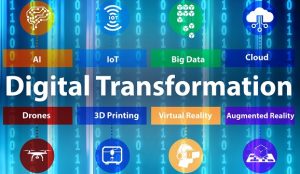 In the past, businesses relied heavily on physical storefronts, foot traffic, and traditional advertising like billboards and flyers to attract customers. However, over the last decade, technological advancements have enabled traditional businesses to embrace digital transformations, redefining how they operate and engage with customers.
In the past, businesses relied heavily on physical storefronts, foot traffic, and traditional advertising like billboards and flyers to attract customers. However, over the last decade, technological advancements have enabled traditional businesses to embrace digital transformations, redefining how they operate and engage with customers.
What Is Digital Transformation?
Digital transformation involves integrating technology into a traditional business—whether in manufacturing, retail, healthcare, or another industry—to optimize operations and enhance processes. Many people associate digital transformation primarily with creating an online store to complement or replace a physical location and boost brand visibility. However, digital transformation encompasses much more than that.
Let's explore three core elements of digital transformation and how they can benefit your business.
Meeting Customer Needs More Effectively
Customers are the backbone of any business. To remain competitive and thrive, businesses must prioritize customer satisfaction. Technologies like machine learning and artificial intelligence (AI) play a significant role in enhancing customer experience through tools such as voice assistants and chatbots. These virtual assistants use natural language processing to understand customer inquiries and emotions, allowing them to provide more empathetic and effective support.
AI-powered systems draw on information from business websites and other sources to answer customer questions and concerns without waiting for a live agent. Additionally, they track customer behavior throughout the purchasing process, analyzing viewing and buying patterns to offer personalized product recommendations. This level of personalization can significantly enhance the customer experience.
Transforming Business Operations
 AI integration also helps optimize business operations by automating routine tasks such as processing orders, returns, and exchanges. Since these processes follow consistent patterns, machines can efficiently handle them, freeing up live agents to focus on unique or complex issues that require a human touch. This results in faster response times and improved customer service.
AI integration also helps optimize business operations by automating routine tasks such as processing orders, returns, and exchanges. Since these processes follow consistent patterns, machines can efficiently handle them, freeing up live agents to focus on unique or complex issues that require a human touch. This results in faster response times and improved customer service.
Automation also benefits business owners by streamlining tasks like sending emails or instant messages about upcoming sales and events, managing inventory, and more. These automated processes reduce human error and enhance overall efficiency, leading to higher productivity.
Leveraging the Right Digital Technologies
Achieving these advancements requires the use of appropriate digital tools, extending beyond AI. For example, integrating smart devices—like smartphones, tablets, smart thermostats, and kitchen appliances—into your physical business space allows these items to connect via the Internet of Things (IoT), enabling seamless data exchange and communication.
These devices can also connect to cloud-based systems, allowing businesses to store data remotely instead of relying on physical servers. Cloud computing provides companies with access to software, data analytics, networking, and other resources over the internet, offering speed, flexibility, and scalability.
By embracing these key elements of digital transformation, traditional businesses can thrive in the digital age, achieving greater efficiency, enhanced customer experiences, and sustained growth. However, implementing digital transformation can be daunting. Integrated Technology Systems works with you team to integrate these processes into your work flow.
Give Integrated Technology Systems a call today to discuss the best way to implement these security and time saving practices into your business.
Integrated Technology Systems
6 East 45th Street, Suite 400
New York, NY 10017
212-750-5420
https://www.itsnyc.com



